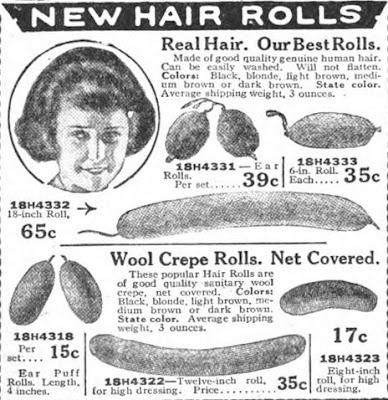While wandering through an antique store, one might come across something that looks like this:
And a thought might cross the mind, "Oh, what a beautiful trinket/powder jar!" Unfortunately, that thought would be wrong. This is a hair receiver, a specially made container for storing ones own hair. Nowadays this might seem like a strange concept, but with more women becoming interested in Edwardian/Gibson girl hairstyles, I feel that a revival in hair receivers is in order.
The most common hair receivers I find are these celluloid ones.
For hundreds of years, women(and men) used human hair in their hair pieces. This hair was used in pieces that were added for volume('hair rolls' and 'puffs') and length('switches' and 'braids'), as well as in the wig industry, not unlike false hair pieces that can be purchased now. Aside from the pieces that were purchased, women would collect their own hair for use in making hair 'rats' or 'ratts'. These 'rats' were used to add volume for the elaborate hairstyles of the Victorian era, as well as for achieving that pompadour or Gibson girl look during the turn of the 20th century. They were also used throughout the next few decades for making rolls on the lower back of the head as well as any other area more volume was wanted.
Sears & Roebuck Co. catalog from 1912 showing human hair rolls as well as mohair ones, the commercial equivalent of homemade hair rats.
Another example from a Montgomery Ward catalog from 1916 showing hair rolls made from wool.
And finally, another Sears & Roebuck Co. catalog from 1922 showing human hair rolls as well as wool ones.
During my antiquing adventures I've come across quite a few hair receivers and admittedly was clueless as to their usage until one was very clearly marked 'hair receiver'. It was then that it clicked - and my desire to acquire all things vintage living told me that I must buy and use one of these. So after seeing the usual celluloid ones time and time again, I found one that was unique from the rest and a very good price(hair receivers range in price from $5-$30 depending on whether they are made from cheaper plastics like lucite and celluloid or porcelain and metal with glass).
My hair receiver - made of glass and some sort of metal, with an 18th century scene depicted on the lid.
Now comes the part which requires a lot of patience - collecting the hair. This depends on several factors: the length of the hair, how often it is brushed, how much the hair naturally sheds when brushed, and just how big the hair rat is to be. I have long, thick hair and I've been collecting for about a year now. Note that I don't save hair when I travel(which is fairly often), only what is collected in my brush while I'm home.
What I've saved to this point.
From what I have, I've decided to make one large hair rat, which I can use for Edwardian styles should I desire(though for a very Gibson Girl look a few more might be needed), or more practically for the low back of the head rolls common from the 1910s-1930s(my preferred aesthetic).
Of course, the ball of hair collected could be used as is, but I decided to encase my hair into a hair net to help keep unruly hairs in order.
The hair net I'm using.
I pulled apart and molded the hair together since it was put in at various times in varying amounts to form one large mass of hair. I then stuffed the hair into the net and moved it around to be the shape I desired.
The hair in the net.
To keep the hair from falling out of the net I somewhat loosely blanket-stitched the opening closed, and trimmed some of the hairs that were sticking out(I may in the future add a second net after some wear, but this will do for now).
The thread I used - the closest to my hair color, which I luckily had on hand.
Close up of the stitches.
And voila! A homemade hair rat.
Finished hair rat and freshly emptied hair receiver.
There are a few advantages to making a hair rat instead of buying one: a) it will match hair color perfectly since it is your own hair, b) if any bit of it peeks out while being worn, it will be invisible because it's real hair, not plastic, and c) it's free!(aside from the hair net, thread, and hair receiver, which are all completely optional)

















Really interesting! One learns new things every day. Thanks for taking the time to write this history lesson!
ReplyDeleteThank you, I'm so glad you found it interesting!
DeleteJust found this. Thanks for the info
ReplyDeleteThank you for sharing! A friend recently shared her Victorian hair collection with me, and I'm fascinated by this topic! I'm creating a video about it for my YouTube channel, and appreciate the links to your sources, too. :)
ReplyDelete